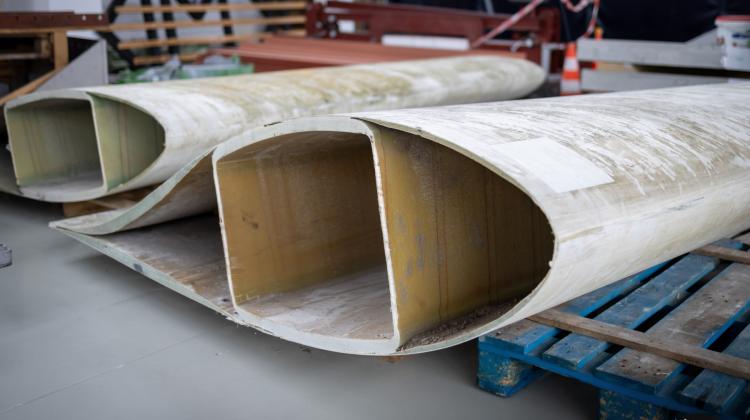Poland needs regulations regarding wind turbine noise standards and rules, says expert
 Moszczenica, 08.07.2022. Wind turbines near Moszczenica, July 8th. (gm/doro PAP/Grzegorz Michałowski)
Moszczenica, 08.07.2022. Wind turbines near Moszczenica, July 8th. (gm/doro PAP/Grzegorz Michałowski)
According to applicable regulations, wind turbines are treated like any other source of industrial noise. This needs to change, says Professor Anna Preis from the Adam Mickiewicz University in Poznań, leader of the HETMAN project, which investigated the noise of wind turbines.
Wind turbines are a relatively new source of noise, which began to be analysed in detail by acousticians only in the 21st century. In research on noise annoyance, there is a common view that the louder the noise, the more annoying it is. 'This statement is true for noise sources such as airplanes, railways and cars,’ says Professor Preis. She points out that the noise generated by wind turbines is quieter than those sound sources, and yet, at the same sound level, the noise of a wind turbine is perceived as more annoying.
For several years, countries have been gradually introducing noise standards relating to this new sound source. In Poland, turbines are still treated as 'other objects and activities that are a source of noise', and the possibility of erecting them in relation to houses - according to the HETMAN project experts - is determined by the '10H' regulation.
This regulation introduced the requirement to maintain an appropriate distance for newly built wind farms from buildings, specifying that this distance should be at least 10 times the total height of the turbine including the blades.
'No other country has regulations regarding wind turbines expressed +in meters+, as is the case in Poland, but in the values of sound levels permissible for this type of noise,’ Professor Preis tells PAP - Science in Poland. She adds that the exception is probably Bayern, Germany, where meters are also mentioned.
'The issue of meters should disappear from the regulation on permissible sound levels for wind turbines,’ she adds. In her opinion, this is important because the same turbine, at the same distance from the house, can generate noise that will vary by up to 10 dB depending on the wind speed.
Professor Preis argues that the criterion of nuisance expressed in meters makes no sense. 'With respect to other noise sources, no one would think of establishing a criterion for car noise annoyance in meters, i.e. the distance of the highway from houses. For all other noise sources this is done in relation to the sound level. Why should turbines be an exception?,’ she says.
Over the course of three years, a team of scientists working in the HETMAN project investigated noise nuisance from wind turbines, possible methods of noise monitoring and forecasting, the impact of infrasound on human health and methods of reducing turbine noise.
According to Professor Preis, the noise of wind turbines does not pose a threat to human health. 'At most, it may be irritating to some people. However, if appropriate conditions are met, i.e. the permissible sound level values are not exceeded, even the impression of annoyance should not appear,’ she says.
As part of the project, the scientists investigated what physical parameters of wind turbine noise determined the sensation of annoyance and how it could be minimized.
'The most important result of the project is the proposal of the permissible sound level for wind turbine noise, confirmed by measurements and surveys in the field, and by laboratory experiments. These values only apply to wind turbine noise, they are different for other noise sources,’ Preis says.
Currently, wind turbine noise is classified as 'other objects and activities that are a source of noise'. The scientists propose that there should be separate requirements for wind turbines and that the assessment time should change from 8 hours of day/1 hour of night to 16 hours of day/8 hours of night. The proposed changes also concern the simplification of the classification of types of areas subject to acoustic protection (the same permissible value for all types of residential areas). Depending on the type of area, the proposed values are: 45-50 dB for daytime (currently 45-55 dB), and 40-45 dB for night time (unchanged).
In addition, the experts propose to define and standardize the guidelines for wind turbine noise management. 'These guidelines will appear in the Good Practice Guide we are preparing, they should be observed at every stage of operation of a wind turbine farm, from planning to control of the operation of a given farm,’ says Professor Preis.
The document will describe in detail, among other things, the method of measuring wind turbine noise, the types of measurements that should be performed when monitoring the operation of such a farm, what should be done when permissible noise levels are exceeded, etc. It will also include instructions for farm managers on how to reduce wind turbine noise when, for example, there are complaints from residents.
'We hope that the data and conclusions we have presented will become the basis for a thorough regulation of the issue of wind turbine noise in Polish legislation,’ the acousticians say.
In their opinion, 'Poland faces many challenges related to the increasingly dynamic development progress of renewable energy'. 'The sooner we regulate issues related to its development, the sooner we will be able to focus on the real benefits of using renewable energy.’
As part of the HETMAN project, a monitoring station for noise generated by wind turbines has also been built.
The project POL/NOR 2019 'Healthy society - towards optimal management of wind turbines' noise' (acronym: HETMAN) was a scientific response to ongoing discussions in both the media and the political community about noise and the potential harmfulness of wind turbines.
The project was carried out by a consortium of entities. Its leader is the Adam Mickiewicz University in Poznań, accompanied by: the research institute SINTEF, Trondheim (the Norwegian partner), the AGH University of Science and Technology in Kraków, the Central Mining Institute in Katowice, the Institute of Occupational Medicine in Łódź and the Institute of Environmental Protection in Warsaw. Business partners included Akustix, a comprehensive noise monitoring company, and the Polish Wind Energy Association. The project consisted of a total of seven tasks. The HETMAN project was financed by Norwegian funds and the state budget; its operator was the National Centre for Research and Development.
PAP - Science in Poland, Anna Mikołajczyk-Kłębek
amk/ agt/ lm/ kap/
tr. RL
Przed dodaniem komentarza prosimy o zapoznanie z Regulaminem forum serwisu Nauka w Polsce.


















